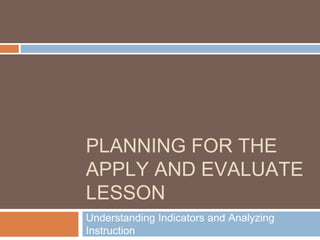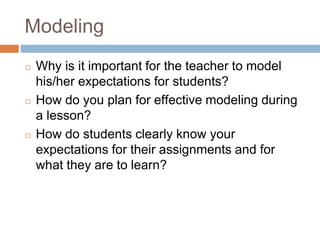PIC & Thinking
- 1. PLANNING FOR THE APPLY AND EVALUATE LESSON Understanding Indicators and Analyzing Instruction
- 2. Objectives ◻ I can review Presenting Instructional Content descriptors ◻ I can review Thinking descriptors ◻ I can understand the expectations for the A and E assignment
- 3. What Does TAP Say About PIC? 3 Priority TAP order 1 Visuals that establish: a) the purpose of the lesson, b) preview of the organization of the lesson c) include internal summaries of the lesson 2 Examples, illustrations, analogies, and labels for new concepts and ideas. 3 Modeling by the teacher to demonstrate his or her performance expectations. 4 Concise communication 5 Logical sequencing and segmenting all essential information 6 No irrelevant, confusing or non-essential information
- 4. YOUR TURN: Prioritize ◻ There are 6 bullets and 3 sub-bullets listed under Presenting Instructional Content. ◻ Prioritize the bullets based on what you think are most important. ◻ Be ready to explain your choices. 4
- 5. Share your order… Visuals that establish: a) the purpose of the lesson, b) preview of the organization of the lesson c) include internal summaries of the lesson Examples, illustrations, analogies, and labels for new concepts and ideas. Modeling by the teacher to demonstrate his or her performance expectations. Concise communication Logical sequencing and segmenting all essential information No irrelevant, confusing or non-essential information
- 6. MY ANSWERS: Prioritize 6 Priority TAP order Descriptor for Presenting Instructional Content 3-2 1 Visuals that establish: a) the purpose of the lesson, b) preview of the organization of the lesson c) include internal summaries of the lesson 4 2 Examples, illustrations, analogies, and labels for new concepts and ideas. 2-3 3 Modeling by the teacher to demonstrate his or her performance expectations. sympto m 4 Concise communication 1 5 Logical sequencing and segmenting all essential information sympto m 6 No irrelevant, confusing or non-essential information
- 7. Modeling ◻ Why is it important for the teacher to model his/her expectations for students? ◻ How do you plan for effective modeling during a lesson? ◻ How do students clearly know your expectations for their assignments and for what they are to learn?
- 8. SOME CRITICAL ATTRIBUTES OF MODELING: 1. Break tasks to be learned into clearly defined steps or processes that are visually organized or ordered. 2. Make the steps easy to understand and easy to see. 3. Align steps to actions and visuals. 8
- 9. INFORMAL ASSESSMENT: Find the example that probably includes effective modeling and why 1. Teacher passes out worksheet and goes over the first problem. 1. Teacher teaches the ‘3 steps’ needed to solve problems while she solves the problem. 1. Teacher solves a problem on the overhead then asks students to solve the next problem.
- 10. INFORMAL ASSESSMENT: Find the example that probably includes effective modeling and why 1. Teacher passes out worksheet and goes over the first problem. 1. Teacher teaches the ‘3 steps’ needed to solve problems while she solves the problem. 1. Teacher solves a problem on the overhead then asks students to solve the next problem.
- 11. Visuals ◻ Visuals are anything seen by students as content: ◻ on the board ◻ on the walls ◻ on the overhead ◻ on the document camera ◻ in a book ◻ what you gesture ◻ what you demonstrate 11
- 12. Regarding Instruction….. ◻ Telling when used alone, results in 70% recall three hours later and 10% recall three days later. ◻ Showing when used alone, results in 72% recall three hours later, and 20% recall three days later. ◻ A blend of telling and showing results in 85% recall three hours later and 65% recall three days later.
- 13. What are internal summaries?? ◻ “It is important to note that internal summaries (mini reviews within a lesson of what has been taught) may be provided visually or orally by the teacher and students. When a teacher continually reviews sub- objectives in order to connect to the next sub- objective, students are led to ultimately move towards mastery of the lesson objective. Internal summaries provide students opportunities to have concepts restated and to reflect within a lesson on what they are learning as opposed to waiting for a review of all concepts at the end of the lesson. Teachers can lead students in providing these summaries through his/her questions and group discussions. “ ◻ ©2010 National Institute for Excellence in Teaching.
- 14. Look at your A and E lesson plan… ◻Where do you see evidence in your plan of: Visuals that establish the purpose of the lesson, preview the organization of the lesson, and include internal summaries of the lesson Modeling by the teacher to demonstrate his or her performance expectations; Examples, illustrations, analogies, and labels for new concepts and ideas;
- 15. What about thinking? Significantly Above Expectations (5) At Expectations (3) Significantly Below Expectations (1) Thinking The teacher thoroughly teaches two or more types of thinking: • analytical thinking, where students analyze, compare and contrast, and evaluate and explain information; • practical thinking, where students use, apply, and implement what they learn in real-life scenarios; • creative thinking, where students create, design, imagine, and suppose; and • research-based thinking, where students explore and review a variety of ideas, models, and solutions to problems. The teacher provides opportunities where students: • generate a variety of ideas and alternatives; • analyze problems from multiple perspectives and viewpoints; and • monitor their thinking to ensure that they understand what they are learning, are attending to critical information, and are aware of the learning strategies that they are using and why. The teacher thoroughly teaches one type of thinking: • analytical thinking, where students analyze, compare and contrast, and evaluate and explain information; • practical thinking, where students use, apply, and implement what they learn in real- life scenarios; • creative thinking, where students create, design, imagine, and suppose; and • research-based thinking, where students explore and review a variety of ideas, models, and solutions to problems. The teacher provides opportunities where students: • generate a variety of ideas and alternatives; and • analyze problems from multiple perspectives and viewpoints. The teacher implements no learning experiences that thoroughly teach any type of thinking. The teacher provides no opportunities where students: • generate a variety of ideas and alternatives; or • analyze problems from multiple perspectives and viewpoints.
- 16. The teacher thoroughly teaches one type of thinking: ◻ Analytical ◻ Practical ◻ Creative ◻ Research
- 17. What is practical thinking? ◻ use and apply to real life situations ◻ How can we use the ABC punctuation to apply to real life? By connecting this activity to REAL reading and paying attention to punctuation to change our voices.
- 18. What is creative thinking? ◻ create, design, imagine and suppose ◻ How can this Graphic Organizer be modified to encourage creative thinking? ◻
- 19. What is creative thinking? ◻ create, design, imagine and suppose ◻ Maybe the students will create the layers of the rain forest through drawing? OR Imagine they live in the RF. What layer would they live on and why? ◻
- 20. What is research-based thinking? ◻ explore and review a variety of ideas, models and solutions to problems
- 21. Thinking also says… The teacher also provides opportunities where students generate ideas and analyze problems from multiple perspectives.
- 22. The teacher also provides opportunities where students generate ideas and analyze problems from multiple perspectives. These 5th graders learned about inferring by looking at the picture and making inferences about what they see. Because there are many ideas listed and different students have different ideas students are using multiple perspectives.
- 23. The teacher also provides opportunities where students generate ideas and analyze problems from multiple perspectives. These students picked their favorite person…their teacher They wrote an expository text on why she is their favorite in SHARED WRITING to convince the school that she is the BEST!
- 24. The teacher also provides opportunities where students generate ideas and analyze problems from multiple perspectives.
- 25. Think about how author’s purpose is an example of using multiple perspective….
- 26. Modeling for your A and E lesson (an example) TEK from Guided Reading lesson: ◻ (B) identify important facts or details in text, heard or read; Objective from Guided Reading lesson: ◻ The student will read and identify facts and details found in their guided reading book.
- 27. In the guided reading portion, I will: ◻ Question before and after the reading with What if you had a pet lion? What would this lion need to survive in Lubbock? ◻ (generating ideas AND multiple perspectives!)
- 28. After guided reading, we would use our objective of facts and details to determine: Big 5/Vocabulary lesson: ◻ Semantic Web of lions (what they look like, where they live, other) Lives: Looks like: Other interesting facts: ◻ Here I would be MODELING. Also, I would go back to the objective (internal summary). This would include a visual AND because we are working on facts and details my thinking would be RESEARCH! Finally, because this is together, we are GENERATING IDEAS. Lions
- 29. After the vocabulary chart.. Writing: ◻ Write one fact that you learned about lions/tigers using one of the words from the index of the book or from the web. Try to include a detail with this fact. ◻ I could model this first. And again, because I want them to go to the index or web, we are researching.
- 30. ◻ Remember: ◻ 1. The 2 indicators for this A & E assignment ◻ 2. One is Presenting Instructional Content and the other is Thinking. ◻ 3. To get a 3 in PIC, you need to model, provide internal summaries, and include visuals that establish the purpose. ◻ 4. To get a 3 in Thinking, you need to teach one type of thinking thoroughly AND analyze from different perspectives AND generate a variety of ideas.
- 31. Why are we doing this A and E assignment? “Learning deepens when students (and teachers!) engage in reading, talking and writing across many different instructional contexts.” Fountas and Pinnell, 2007 For more information about the A and E assignment, please refer to the syllabus, in Appendices 1-6.
- 32. Objectives ◻ I can review Presenting Instructional Content descriptors ◻ I can review Thinking descriptors ◻ I can understand the expectations for the A and E assignment































